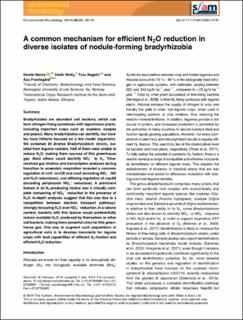| dc.contributor.author | Mania, Daniel | |
| dc.contributor.author | Woliy, Kedir | |
| dc.contributor.author | Degefu, Tulu | |
| dc.contributor.author | Frostegård, Åsa | |
| dc.date.accessioned | 2020-07-28T07:18:18Z | |
| dc.date.available | 2020-07-28T07:18:18Z | |
| dc.date.created | 2019-09-25T10:21:21Z | |
| dc.date.issued | 2019 | |
| dc.identifier.citation | Environmental Microbiology. 2019, 22 (1), 17-31. | en_US |
| dc.identifier.issn | 1462-2912 | |
| dc.identifier.uri | https://hdl.handle.net/11250/2670287 | |
| dc.description.abstract | Bradyrhizobia are abundant soil bacteria, which can formnitrogen-fixing symbioses with leguminous plants, including important crops such as soybean, cowpea and peanut. Many bradyrhizobia can denitrify, but studies have hitherto focused on a few model organisms. We screened 39 diverse Bradyrhizobium strains, isolated from legume nodules. Half of them were unable to reduce N2O, making them sources of this greenhouse gas. Most others could denitrify NO3 − to N2. Timeresolved gas kinetics and transcription analyses during transition to anaerobic respiration revealed a common regulation of nirK, norCB and nosZ (encoding NO2 −, NO and N2O reductases), and differing regulation of napAB (encoding periplasmic NO3 − reductase). A prominent feature in all N2-producing strains was a virtually complete hampering of NO3 − reduction in the presence of N2O. In-depth analyses suggest that this was due to a competition between electron transport pathways, strongly favouring N2OoverNO3 − reduction. In a natural context, bacteria with this feature would preferentially reduce available N2O, produced by themselves or other soil bacteria,making them powerful sinks for this greenhouse gas. One way to augment such populations in agricultural soils is to develop inoculants for legume crops with dual capabilities of efficient N2-fixation and efficient N2O reduction. | en_US |
| dc.language.iso | eng | en_US |
| dc.rights | Navngivelse-Ikkekommersiell 4.0 Internasjonal | * |
| dc.rights.uri | http://creativecommons.org/licenses/by-nc/4.0/deed.no | * |
| dc.title | A common mechanism for efficient N2O reduction in diverse isolates of nodule-forming bradyrhizobia | en_US |
| dc.type | Peer reviewed | en_US |
| dc.type | Journal article | en_US |
| dc.description.version | publishedVersion | en_US |
| dc.source.pagenumber | 17-31 | en_US |
| dc.source.volume | 22 | en_US |
| dc.source.journal | Environmental Microbiology | en_US |
| dc.source.issue | 1 | en_US |
| dc.identifier.doi | 10.1111/1462-2920.14731 | |
| dc.identifier.cristin | 1728701 | |
| dc.relation.project | EC/H2020/290488 | en_US |
| dc.relation.project | Norges forskningsråd: 290488 | en_US |
| cristin.unitcode | 192,12,0,0 | |
| cristin.unitname | Kjemi, bioteknologi og matvitenskap | |
| cristin.ispublished | true | |
| cristin.fulltext | original | |
| cristin.qualitycode | 2 | |

